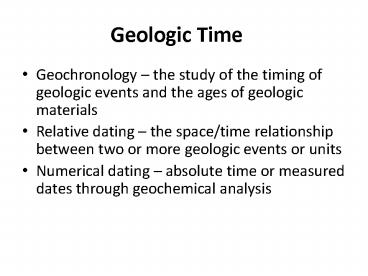Geologic Time PowerPoint PPT Presentation
1 / 18
Title: Geologic Time
1
Geologic Time
- Geochronology the study of the timing of
geologic events and the ages of geologic
materials - Relative dating the space/time relationship
between two or more geologic events or units - Numerical dating absolute time or measured
dates through geochemical analysis
2
Principles of Relative Age Dating
- Uniformitarianism James Hutton The present is
the key to the past. - Horizontality/Superposition Layers were
originally laid down horizontally with oldest at
bottom/youngest at top - Cross-cutting relationships any intrusive
formation must be younger than the rocks it
intrudes or cuts. - Inclusions must be older material picked up
during intrusion - Faunal succession there is a direct link
between the procession of fossils and time (e.g.
once a plant/animal becomes extinct it is never
seen again)
3
Unconformities
- Gaps in geologic record forming boundaries that
separate rocks of different ages. - Non-conformity (pg. 251) boundary between
unlayered intrusion and overlying sedimentary
rocks - Angular unconformity (Fig. 9.6) nonconforming
boundary between horizontal rocks that are
rotated and overlying rocks that were deposited
horizontally - Disconformity (pg. 251) boundary between
parallel layers of sedimentary rocks
4
Great Unconformity of the GC(angular
unconformity)
5
Great Unconformity of GC(nonconformity Tapeats
SS over crystalline basement)
6
Great UnconformityBox Canyon Ouray, Colorado
7
Disconformities in GC(gaps between sedimentary
layers)
8
Correlation
- Rocks that are of the equivalent age but are
separated spatially (Fig.9.9) - Fossil evidence biota of same age
- Key beds short duration event over a wide area
(Ft. Apache Lm. In Sedona) - Facies change within a unit
9
Stratigraphic Sections
10
Correlating Stratigraphic Sections
- Vertical measurement of rock unit thickness
- Section is a hypothetical column of rock units
for a particular area - Multiple sections can be correlated by drawing
lines between similar or identical beds or units - Facies change can be identified if type of rock
between correlated units changes between measured
sections
11
Unit Correlation
12
Stratigraphic Unconformities
13
Numerical Dating Techniques
- Isotope dating rate of decay for radioactive
isotopes uses known rates to measure the time
elapsed since mineral formation - Half life time it takes half the atoms of the
parent isotope to decay into daughter isotopes
(Fig.9.15) - Typically more useful for igneous rocks
- Most reliable in closed system
- Limited by time
- Uranium-thorium-lead 10million to 4.6 billion
only for oldest rocks - Potassium-argon 100,000 to 4.6 billion very old
and very young dates - Rubidium-strontium 10 million to 4.6 billion
half-life only rocks gt 10my - Carbon 14 good for lt 100,000 yrs old
14
Radioactive Parent Stable Daughter Half life
Potassium 40 Argon 40 1.25 billion yrs 1.25 billion yrs
Rubidium 87 Strontium 87 48.8 billion yrs 48.8 billion yrs
Thorium 232 Lead 208 14 billion years 14 billion years
Uranium 235 Lead 207 704 million years 704 million years
Uranium 238 Lead 206 4.47 billion years 4.47 billion years
Carbon 14 Nitrogen 14 5730 years 5730 years
15
Parent/Daughter Ratio
16
How does Carbon-14 dating work?
- Cosmic rays from the sun strike Nitrogen 1 4
atoms in the atmosphere and cause them to turn
into radioactive Carbon 14, which combines with
oxygen to form radioactive carbon dioxide. - Living things are in equilibrium with the
atmosphere, and the radioactive carbon dioxide is
absorbed and used by plants. The radioactive
carbon dioxide gets into the food chain and the
carbon cycle. - All living things contain a constant ratio of
Carbon 14 to Carbon 12. (1 in a trillion). - At death, Carbon 14 exchange ceases and any
Carbon 14 in the tissues of the organism begins
to decay to Nitrogen 14, and is not replenished
by new C-14. - The change in the Carbon 14 to Carbon 12 ratio is
the basis for dating. - The half-life is so short (5730 years) that this
method can only be used on materials less than
70,000 years old. Archaeological dating uses this
method.) Also useful for dating the Pleistocene
Epoch (Ice Ages). - Assumes that the rate of Carbon 14 production
(and hence the amount of cosmic rays striking the
Earth) has been constant (through the past 70,000
years).
17
Geologic Time Scale(Fig. 9.17)Read Box 22.3
- Eons
- Eras
- Cenozoic Age of mammals, early primates, Ice
Ages, man (3.4-3.8mya), spread of modern humans
last 10,000yrs. - Mesozoic, age of dinosaurs, early flowering
plants, formation of the Rocky Mountains - Paleozoic, - Mt. Building in N.A. and Eur., early
land plants, coal forming swamps - Precambrian 4.6by Earth forms, 1.5by Pangaea
forms, .5by first multi-celled organisms
18
Periods Breakdown of Eras
- Paleozoic
- Permian
- Pennsylvanian
- Mississippian
- Devonian
- Silurian
- Ordovician
- Cambrian

